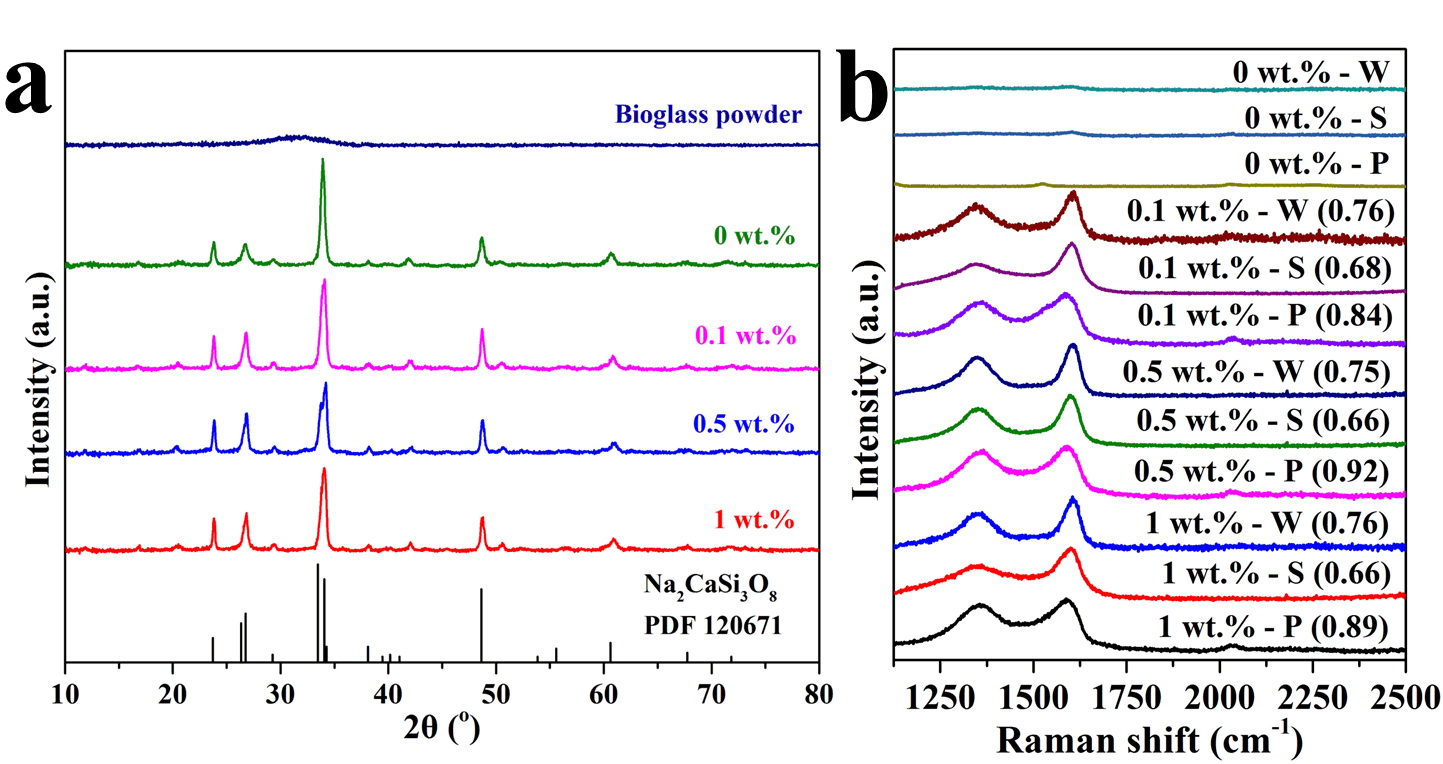Introduction: The insufficient fracture toughness of 45S5 Bioglass® (45S5) constraints its extensive application as major load-bearing orthopedic implants[1],[2]. Satisfactory wear resistance is crucial for the in vivo fixation, integration and lifetime of 45S5-based prosthesis, but the tribological properties of bulk 45S5 are rarely reported[3],[4]. This study attempts to fabricate graphene nanoplatelet (GNP) toughened 45S5 composites by Spark Plasma Sintering (SPS) and investigate the effect of GNP addition on the composite’s wear properties.
Materials and Methods: 45S5 powder was supplied by XL Sci-Tech Inc., US. Graphene oxide (GO) was synthesized using a modified Hummers method[5]. A colloidal process was utilized to obtain the GO/45S5 composite powders. The composites were sintered at 550°C for 3 min by an SPS system (Dr. Sinter 1050, SCM, Japan). In situ reduction of GO and enhancement of 45S5 matrix were simultaneously realized in this process. Sintered pellets with 0, 0.1, 0.5, and 1 wt.% GO added in the raw powder are denoted as BG0, BG0.1, BG0.5 and BG1, respectively. Samples were extensively characterized by SEM, TEM, Raman Spectroscopy, XRD, XPS, Nanoindentation, and Vickers indentation fracture toughness test[6]. Tribological properties were investigated by a ball-on-disk micro-tribological test (CSM High Temperature Tribometer, Switzerland) and surface profilometry.
Results and Discussion: While the pristine 45S5 powder was amorphous, the sintered pellets were crystalline (Fig. 1a). Raman spectra shown in Fig. 1b prove that GNP survived the SPS process. The significantly decreased defect index ID/IG (intensity ratio of the D band and G band, values given in brackets) of sintered composites ("S" – sintered pellet, "P" – powder, and "W" – wear track) can be attributed to the restoration of sp2 bonds in the graphitic lattice[7].

Composite pellets showed lower Young’s modulus (E) and hardness (H) than BG0 (Fig 2a), possibly caused by more residual pores introduced by GNP addition. BG0.5 possessed the highest E and H among the three composites.
All composite pellets showed higher fracture toughness (KIC) than BG0 (Fig. 2b). BG0.5 had the highest KIC of 1.22 MPa∙m1/2, corresponding to an exciting improvement of 130.2 % compared with BG0. Different toughening mechanisms, including crack deflection, crack bridging and sheet pull-out, can be clearly seen in Fig. 2c-f.

BG0.5 showed the best wear resistance with the shallowest wear track (Fig. 3). Compared with BG0, its friction coefficient and specific wear rate were decreased by 21.3 % and 62.0 %, respectively, because of its improved KIC and the lubrication effect of GNP[8]. Wear resistance decreased from BG0.5 to BG1, possibly due to excessive GNP loading.

The obviously increased ID/IG values after wear tests probably stem from new structural defects introduced by tearing off of graphene layers during repeated sliding.
Conclusions: Novel GNP/45S5 nanocomposites were successfully fabricated through in situ GO reduction in SPS. The addition of 0.5 wt.% GO was proved to be the optimum which could improve KIC by 130.2 % and decrease friction coefficient and specific wear rate by 21.3 % and 62.0 %, respectively. The encouraging and exciting enhancement in both fracture toughness and wear resistance achieved in our study has opened new doors for broader application of 45S5 in bone tissue engineering.
Z. Li thanks NTU for the University Research Scholarship
References:
[1] L.L. Hench, J. Wilson, Surface-active biomaterials, Science. 226 (1984) 630-636.
[2] L.L. Hench, The story of Bioglass®, Journal of Materials Science: Materials in Medicine. 17 (2006) 967-978.
[3] M. Amaral, C.S. Abreu, F.J. Oliveira, J.R. Gomes, R.F. Silva, Biotribological performance of NCD coated Si3N4–bioglass composites, Diamond and Related Materials. 16 (2007) 790-795.
[4] Q.Z. Chen, J.L. Xu, L.G. Yu, X.Y. Fang, K.A. Khor, Spark plasma sintering of sol–gel derived 45S5 Bioglass®-ceramics: Mechanical properties and biocompatibility evaluation, Materials Science and Engineering: C. 23 (2011) 494-502.
[5] X.-Z. Tang, Z. Cao, H.-B. Zhang, J. Liu, Z.-Z. Yu, Growth of silver nanocrystals on graphene by simultaneous reduction of graphene oxide and silver ions with a rapid and efficient one-step approach, Chemical Communications. 47 (2011) 3084-3086.
[6] G. Anstis, P. Chantikul, B.R. Lawn, D. Marshall, A critical evaluation of indentation techniques for measuring fracture toughness: I, direct crack measurements, Journal of the American Ceramic Society. 64 (1981) 533-538.
[7] N.-J. Song, C.-M. Chen, C.X. Lu, Z. Liu, Q.-Q. Kong, R. Cai, Thermally reduced graphene oxide films as flexible lateral heat spreaders, Journal of Materials Chemistry A. 2 (2014) 16563-16568.
[8] N.W. Khun, H. Zhang, J. Yang, E. Liu, Tribological performance of silicone composite coatings filled with wax-containing microcapsules, Wear. 296 (2012) 575-582.